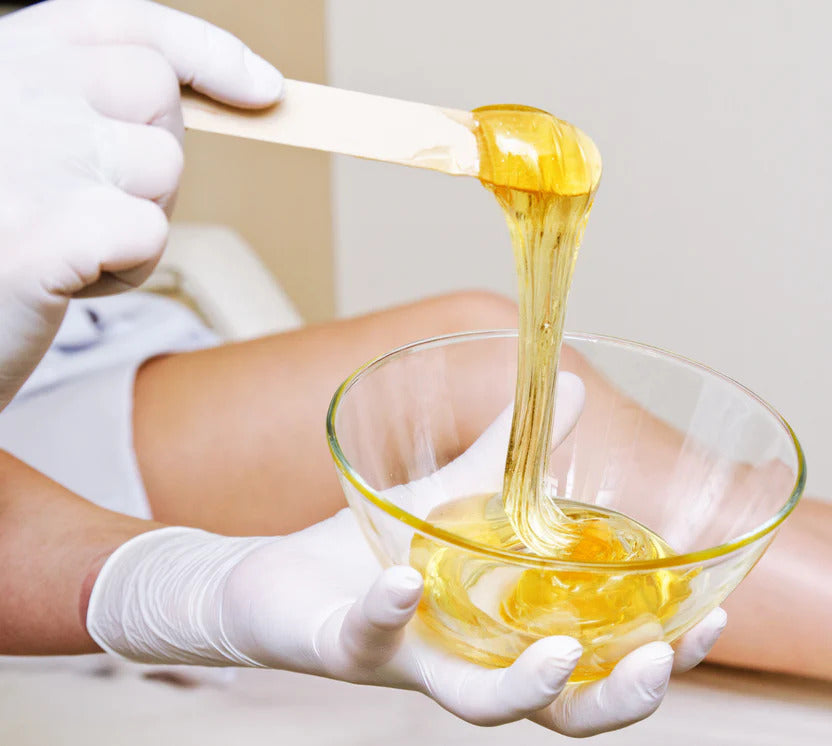Is Waxing Right for My Skin Type?

Open a fashion mag and you’ll see hairy armpits and other hair trends making a comeback (heck – even the mullet keeps on kicking!) Hairy moments are definitely in right now. But if you prefer regular hair removal upkeep, we’re here to guide you through everything you need to know about waxing to keep your skin feeling peachy – peach fuzz and all.
What exactly is waxing?
Waxing is a hair removal method. The wax removes hair from the root, and it takes about 3 to 8 weeks for the new hair to grow – depending on all kinds of things like genetics, hair growth rate and more. Waxing can be done on almost any part of the body, which is great news for hairy people everywhere – but as with any kind of hair removal technique – there are some things to watch out for.
Also: Use Sundae shower foam for shaving
Soft, hard, strip – what’s the difference?
There are many waxing techniques to explore, from hard wax to soft wax to strip wax, with options for DIY or salon treatments.
Soft wax is best for big areas like your back, legs, and arms, whereas hard wax is thicker and hardens on your skin. It’s great for sensitive areas like your bikini line, underarms, and face (and you peel it off by hand, so it’s less painful.) As for strip wax: this is a type of soft wax that also uses strips for removal. It’s typically used on larger areas but can be more irritating since it sticks to the skin.
Why do people love waxing?
Many people are moving away from shaving because it requires daily upkeep, can irritate sensitive skin, or simply isn't enjoyable, while laser hair removal can be costly and doesn’t work well on every hair type. On the flip side, waxing provides longer-lasting results and smoother skin, with the added benefit of potentially reducing hair growth over time.
Common waxing concerns
Before you get waxy with it (or visit the salon), there are a few things to consider.
Germs and infection
Waxing removes the hair from the follicle, so it pulls the hair out by the root. This gives germs a one-way ticket to the opened hair follicles, which is why it’s so important to prioritize waxing prep and post-care.
Irritation
Sometimes, waxing also removes the top layer of dry, dead skin cells (which is why you might find your tan looking a little lighter after a waxing session). This might leave your skin smoother, but it also means it's vulnerable to irritation.
Wax burns
Heated wax can burn the skin, so if you’re DIY’ing at home, be sure to check the temperature, and if getting a professional service, ask the beautician to make sure it’s not too hot (and do speak up if it’s burning your skin).
Pain and discomfort
Let’s not sugarcoat it – waxing can be painful for many people! While not all pain tolerances are equal, some people find waxing to be pretty uncomfortable and not worth the pain.
Ingrown hair cysts
Ingrown hair cysts can pop up when your waxed hair starts to grow back. Instead of growing toward the surface, the hair grows into the skin, causing a bump, which is more common with curly hair. If it becomes inflamed, it may result in a cyst. Not all ingrown hair cysts are infected, but taking steps to prevent ingrown hairs from developing and treating them properly can reduce the chance of infection.
Waxing and Different Skin Types
So, is waxing right for your skin type? Here’s the deal:
Normal Skin: Waxing is generally well-tolerated for those with normal skin types. Just follow standard pre- and post-wax care routines to keep your skin smooth and healthy.
Oily Skin: Oily skin tends to handle waxing well, as excess oil can actually help reduce the discomfort. But, it’s still important to keep the skin clean and avoid waxing over areas with active breakouts or excessive oil to prevent skin issues.
Dry Skin: Dry skin can be more prone to irritation after waxing. To avoid this, you can moisturize well before and after waxing. Applying a soothing, hydrating lotion afterwards can help keep your skin happy.
Sensitive Skin: Oh hey there, sensitive skin baddies! Waxing can be challenging for you, as it might cause redness, irritation, or even a rash. However, using gentle, hypoallergenic waxes and pre- and post-wax care products designed for sensitive skin can help minimize these issues. Also, hard wax is often recommended for sensitive areas because it’s less likely to pull at the skin.
Pre and post-waxing tips
Don’t forget to patch test: Always test the wax on a small area of skin before a full treatment.
Watch for reactions: Watch for signs of irritation such as redness, rash, or itching. If any of these occur, avoid waxing and consult a professional.
Prep your skin: Exfoliate the area to remove dead skin cells and reduce the risk of ingrown hairs. Use gentle exfoliators or chemical exfoliants (e.g., AHAs).
🍵 You’ll Love: Green Tea Exfoliating Body Wash
Hydrate before waxing: Keeping your skin well moisturized before waxing is always a good idea! Just be sure to use a moisturizer that is suitable for your skin type.
Say hello to Aloe: If your skin is extra sensitive, you can apply an aloe vera gel to calm the skin. (Just avoid products with alcohol or strong fragrances).
Press pause on some products: Immediately after waxing, avoid applying products like perfumes, deodorants (if you are waxing armpits) or exfoliants.
Now that you’re a waxing pro, it’s time to start that beauty routine of yours. You can also check out our Guide to Exfoliating Before or After Shaving while you’re at it.
Happy Sundae x
Written By: Lizzie Waley (Sundae Co-Founder & Body Care Enthusiast) | LinkedIn
Fact Checked: Charnnie Frimpong (Sundae Content Marketing Manager) | Linkedin
